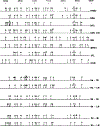Predominance of distinct viral genotypes in brain and lymph node compartments of HIV-1-infected individuals
- PMID: 1684709
- PMCID: PMC9513715
- DOI: 10.1089/vim.1991.4.123
Predominance of distinct viral genotypes in brain and lymph node compartments of HIV-1-infected individuals
Abstract
A modified polymerase chain reaction protocol was used to amplify the entire envelope-coding region of HIV-1 directly from brain and lymph node tissue obtained at autopsy from three HIV-1-infected individuals. Molecular analysis of amplified DNA by digestion with 18 restriction endonucleases, singly and in combination, revealed different HIV-1 genotypes in the brain and lymph node compartments in each of the three individuals. This anatomic compartmentalization of HIV-1 populations may reflect different viral genomic sequences that determine tropism or differences in host immune selection pressures in the brain and lymphoid compartments that drive the emergence of distinct viral populations.
Figures



Similar articles
-
In vivo compartmentalization of human immunodeficiency virus: evidence from the examination of pol sequences from autopsy tissues.J Virol. 1997 Mar;71(3):2059-71. doi: 10.1128/JVI.71.3.2059-2071.1997. J Virol. 1997. PMID: 9032338 Free PMC article.
-
Genomic variation of human immunodeficiency virus type 1 (HIV-1): molecular analyses of HIV-1 in sequential blood samples and various organs obtained at autopsy.J Gen Virol. 1994 Apr;75 ( Pt 4):67-79. doi: 10.1099/0022-1317-75-4-867. J Gen Virol. 1994. PMID: 8151287
-
The viral envelope gene is involved in macrophage tropism of a human immunodeficiency virus type 1 strain isolated from brain tissue.J Virol. 1990 Dec;64(12):6148-53. doi: 10.1128/JVI.64.12.6148-6153.1990. J Virol. 1990. PMID: 2243391 Free PMC article.
-
How does the humoral response to HIV-2 infection differ from HIV-1 and can this explain the distinct natural history of infection with these two human retroviruses?Immunol Lett. 2015 Jan;163(1):69-75. doi: 10.1016/j.imlet.2014.10.028. Epub 2014 Nov 7. Immunol Lett. 2015. PMID: 25445493 Review.
-
Immunological dysregulation of lymph nodes in AIDS patients.Curr Top Pathol. 1991;84 ( Pt 2):157-88. doi: 10.1007/978-3-642-75522-4_5. Curr Top Pathol. 1991. PMID: 2044408 Review.
Cited by
-
Pathogenesis of human immunodeficiency virus infection.Microbiol Rev. 1993 Mar;57(1):183-289. doi: 10.1128/mr.57.1.183-289.1993. Microbiol Rev. 1993. PMID: 8464405 Free PMC article. Review.
-
Primary stage of feline immunodeficiency virus infection: viral dissemination and cellular targets.J Virol. 1994 May;68(5):3080-91. doi: 10.1128/JVI.68.5.3080-3091.1994. J Virol. 1994. PMID: 8151773 Free PMC article.
-
In vivo compartmentalization of human immunodeficiency virus: evidence from the examination of pol sequences from autopsy tissues.J Virol. 1997 Mar;71(3):2059-71. doi: 10.1128/JVI.71.3.2059-2071.1997. J Virol. 1997. PMID: 9032338 Free PMC article.
-
Identification of HIV-1 genitourinary tract compartmentalization by analyzing the env gene sequences in urine.AIDS. 2015 Aug 24;29(13):1651-7. doi: 10.1097/QAD.0000000000000757. AIDS. 2015. PMID: 26372275 Free PMC article.
-
HIV evolution and escape.Trans Am Clin Climatol Assoc. 2004;115:289-303. Trans Am Clin Climatol Assoc. 2004. PMID: 17060974 Free PMC article. Review.
References
-
- Anand R, Thayer R, Srinivasan A, Nayyar S, Gardner M, Luciw P, and Dandekar S. 1989. Biological and molecular characterization of human immunodeficiency virus (HIV-1 BR) from the brain of a patient with progressive dementia. Virology 168:79–89. - PubMed
-
- Budka H 1989. Human immunodeficiency virus (HlV)-induced disease of the central nervous system: pathology and implications for pathogenesis. Acta Neurol. Pathol. 77:225–236. - PubMed
-
- Chiodi F, Valentin A, Keys B. Schwartz S, Asjo B, Gartner S. Popovic M, Albert J, Sundquist V-A, and Fenyo EM. 1989. Biological characterization of paired human immunodeficiency virus type 1 isolates from blood and cerebrospinal fluid. Virology 173:178–187. - PubMed
Publication types
MeSH terms
Substances
Grants and funding
LinkOut - more resources
Full Text Sources
Medical

